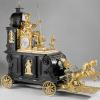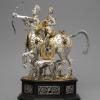Mechanical galleons, Augsburg c. 1585
Commentary
Mechanical Galleon
British Museum
Producer: Hans Schlottheim. Date: 1580-90. Materials: clock dial: silver and enamel; Movement: iron; Hull, masts: gilded brass; movement plates: brass. Dimensions: Height 104 cm, Length 78.5 cm; Width 20.3 cm (excluding cannons). Source: British Museum, number 1866,1030.1 (CC BY-NC-SA 4.0). Details available here.
Description. An automaton in the form of a 'nef' or ship table ornament (Image 1). Within the hull, three separate springs drove multiple clockwork mechanisms. One spring powered the wheels, originally in the base of the hull (now replaced with ball feet), which drove the whole ship forward across the table to announce a banquet. Another spring drove the gears which pumped the bellows (Image 2) to provide air for a tiny ‘regal’ or pipe organ inside the hull, controlled by the large rotating programme barrel on the starboard side (Image 3). The tune, produced for the ten trumpeters on deck, was accompanied by drummers, whose beat was provided by a drum-skin stretched across the base of the ship’s hull. A third spring powered complex movements above decks. On the deck, Emperor Rudolf II is enthroned beneath a canopy emblazoned with the double-headed eagle that symbolised the Holy Roman Empire (Image 4). In front of him, preceded by three heralds, the seven imperial Electors processed (driven by the mechanism shown in Image 5), each bowing as they paid homage and received their fiefs. The same mechanism drove a small clock, mounted at the base of the main mast in front of the emperor (Image 4), showing hours and minutes on a silver dial with coloured enamel floral motifs. In the crows' nests, sailors struck the hours and quarters with hammers on inverted bells, while the tops of the fore and mizzen masts rotated. As a grand finale, the wheel-lock canon in the bowsprit fired, igniting a fast-burning fuse which burnt quickly around the hull, setting off the other ten cannons in succession to finish the performance in a blaze of light, noise, and smoke.
The gilt brass hull is embossed with waves and sea monsters. Three masts, with wire rigging ropes and waxed thread ratlines, support yard arms carrying furled cloth sails. At the top of each mast, a metal pennant flies. On the main deck eight further figures, each with a sword, and two more on the rear deck. A further ten cannons are arranged around the hull.
Further information. This mechanical galleon is number 76 in the British Museum’s History of the World in 100 Objects. An insightful commentary on its broader significance is available in both text and audio (download to listen).
Provenance. The nef described in the inventory of the Kunstkammer of the Elector of Saxony in Dresden matches this vessel in detail. It cannot be identified with the British Museum's galleon with certainty, however, because there was more than one such automaton in existence, including the following.
Mechanical Galleon called the nef ‘De Charles Quint’
Musée de la Renaissance in Écouen
This second example, very similar in design and movement, is preserved in the Musée de la Renaissance in Écouen. Unlike its sister in the British Museum, this second example has been restored to working order. Many of the movements described above can be observed in a seven-minute video. See also David Thompson, Clocks (London, 2004), pp. 52-55.
Ship automaton
Kunsthistorisches Museum, Vienna
Creator: Hans Schlottheim (Naumburg/Saale 1544/47 - 1624/25 Augsburg) - GND. Material: gilt silver, copper alloy, cold enamel, oil paint. Mechanism: iron. Dimensions: Height 67 cm, Width 66 cm, Length c. 67 cm. Source: Kunsthistorisches Museum Wien, Kunstkammer Inv. Nr. 874. Licence: ©KHM-Museumsverband (CC BY-NC-SA 4.0).
Image 6 and Video. This is a smaller, less complex, and presumably earlier mechanical galleons than the two now in London and Écouen. The manner in which the clockwork mechanism drives the ship across the table as the musicians play can be observed in the video below. A first piece of music signals the arrival of the ship's captain: the emperor himself; and a second melody sounds as the vessel starts to move across the table. The year 1585 of the inscription and the imperial double eagle on flags and banners suggest that the ship was intended for Rudolf II. Schlottheim was in Prague in 1587, prior to two periods in Dresden in 1589 and 1593. The existence of superior nefs elsewhere would have been deeply unsatisfactory for Rudolf, unless he also owned one of the superior models as well.
Credit: Howard Hotson (May 2018)


